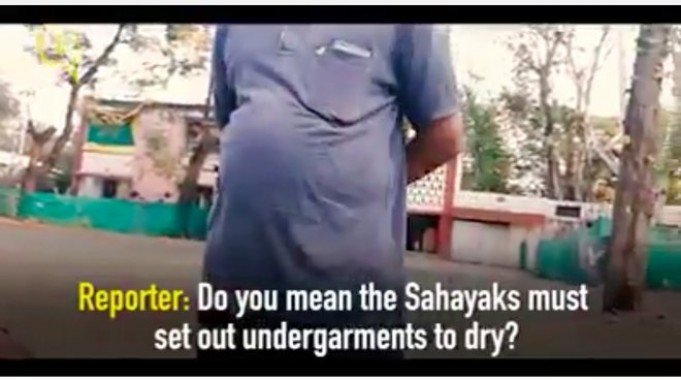Can the army get away with OSA against journo?
The Indian army’s use of the Official Secrets Act and the charge of abetment to suicide against Quint journalist Poonam Agarwal has ended up diverting from the original story of the reprehensible sahayak system, a throwback from the colonial army of the British and definitely not followed by any other army anywhere in the world.
Apart from the feudal use of such sahayaks for the personal work of officers, the other chilling effect on the story is the excessive pressure it unleashed on the Quint journalist to disclose her source and thereafter, punish the officers involved as well as charge the journalist with spying under the Official Secrets Act (OSA) and abetment to suicide under the Indian Penal Code.
Agarwal’s sting video, which recorded the testimonies of five jawans of the abuse they had to face on a daily basis, was aired on February 24. Despite masking the identities of the jawans, it had a tragic fallout: one of them, Gunner Roy Mathew was found dead in his barracks perhaps three or four days after his death as his body was in a highly decomposed condition. Mathew’s family contacted her to ask why they couldn’t get in touch with him. They wanted to file a missing persons complaint but were dissuaded from doing so, she alleged.
Agarwal has filed a counter complaint in Devlali police station against Colonel Anil Jethania, as to why he advised the family against filing the missing person report on March 1.
The Quint took down the story on March 3. An investigation followed and the Quint journalist says she was subject to incredible pressure to disclose her source. “I gave the raw footage of the video to police. They had already questioned the jawans and got the identity of my source, a Kargil war veteran and triple amputee. We cooperated fully with the investigation,” she told The Hoot.
One of the jawans (Lance Naik Nareshkumar Jatav) who featured in the video ended up becoming the complainant. In his FIR (a copy is with The Hoot), he stated that he had met the ‘woman’ who was introduced to him as a relative of the Kargil veteran Deepchand. He had answered questions about the Adam duty, the FIR stated, adding :‘I cannot say when she had recorded the video without our knowledge. However, our statements were cut and distorted to defame the army’.
The Quint founder and co-founder (the website doesn’t list an editor) Raghav Bahl and Ritu Kapur were not named in the complaint. But they are fully supportive of their reporter, Agarwal says. (Quint’s latest story ‘Gunner Roy Mathew’s death:The Quint asks the unanswered questions’ says the original story was ‘taken down in the interest of the investigation and to ensure other jawans were not harassed and driven to the same fate’).
Agarwal also added that Mathew came across as a confident person, angry at the humiliation he had experienced as a sahayak. “He did not seem like a person who would take his own life. I am in constant touch with the family and they assert to this too,” she said. His family has asked for a thorough investigation into the death, petitioning courts to exhume his body and conduct a second post-mortem as they found injury marks on his legs.
Till date, the results of the second post mortem are undisclosed and the Army’s opacity in all aspects of the investigation is there for all to see. Clearly, however, there are several questions raised both by the story as well as the Army’s reaction to it.
The Network of Women in Media, India (NWMI) has condemned the leveling of charges against the journalist under OSA and of abetment to suicide. In a statement, the NWMI said this was clearly a witch-hunt. The journalists’ intent was to be the voice of the underdog, not to compromise national security.

Besides, the ‘army cannot make the claim that Poonam Agarwal was giving out information on the army unless it wishes to make the case that the exploitative ‘sahayak’ or ‘buddy’ system is meant to be an official secret’, the statement said adding that to charge Poonam Aggarwal with abetting the suicide of Lance Naik Mathew was misleading. The lens should apply to the army, and the inquiry they may have conducted on officers and jawans after Ms Aggarwal’s report was released and the role this may have played. If the police is conducting a fair investigation, this is a question that will need to be answered in the course of the inquiry.
According to Agarwal, all attempts were made to speak to the army and obtain their version. In an account on the website, she said she sent four questions to the Army PRO in New Delhi seeking information on the Parliamentary State committee recommending the abolition of the sahayak system and the army’s efforts to do so. On February 28, the latter responded to say there was a proposal to replace combatants with non-combatants for sahayaks.
So, there is no denying the fact that sahayaks do exist and that the system needed to be changed. What then, was the objective of the sting?
Agarwal maintains that her sting was strong evidence of the manner in which the sahayaks are humiliated and made to do menial tasks. “I used a spy camera. There was no other way I could have recorded their testimonies,” she said. It was important to bring this to the notice of a larger public, in public interest. There was no other way to shake the conscience of an indifferent and ignorant public.
Indeed, the Army has seen at least three videos from jawans using mobile camera videos to complain of pathetic food and rations. In January, a video posted by Lance Naik Yagya Pratap Singh, posted in the 42 Infantry Brigade in Dehradun, complained about the abuse of the sahayak system. On March 8, another jawan, identified as Sindhav Jogidas, complained about the quality of food in the army.
The Official Secrets Act
While journalists need to separately debate the ethical aspects of a sting that rendered whistleblowers so vulnerable, we also need to debate the chilling effect of OSA in India. A 1923 act, it extends to the whole of India, including Jammu and Kashmir, and prescribes a maximum 14-year imprisonment for acts prejudicial to the safety or interests of the state.
Even being in the vicinity of a prohibited place can attract the OSA. The OSA covers obtaining records or publishing or communicating to any other person any secret official code or document which even might be indirectly useful to an enemy would come within its ambit.
Interestingly, the Second Administrative Reforms Commission, headed by then law minister M Veerappa Moily, had recommended repeal of the OSA. But clearly, this government has a different approach, cracking down on any media coverage of defence issues it considered unfavourable to it. In a letter dated October 13 2014, the National Security Advisor, Ajit Doval had written to the Cabinet Secretary pointing out that NDTV had broadcast a report relating to INS Arihant, India's nuclear submarine.
It has become a regular practice to violate secrecy laws with impunity, the letter says, adding that ‘firm action needs to be taken in cases that undermine national security’.
In fact, Section 3 of the Act states that a person is liable to be punished only if information obtained by him is intended to be useful to an enemy or relates to a matter that is likely to affect the integrity of India.
Hardly something that will apply to the sahayak system
Geeta Seshu is an independent journalist and consulting editor of the Hoot.
